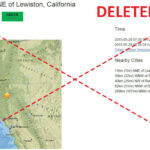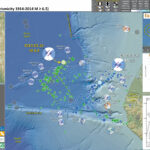You’re invited to come network with old friends and colleagues, meet new ones, enjoy a locally-made beverage, maybe learn something and share your local knowledge with others. Cascadia GeoSciences presents: A Research Presentation by Todd B. Williams and Dr. Jason…
Errata for Phantom Earthquakes: USGS
There have been a couple of reported earthquakes that have since been removed from the database. This happens when seismic waves are incorrectly interpreted by the computers, typically from the results of larger magnitude earthquakes. These large magnitude earthquakes can…
Panama Aftershocks Reveal Likely Fault Solution
All rightee… We have a number of aftershocks that are lighting up the potential fault that ruptured a couple days ago. Here is my page for this earthquake. Here is the USGS page. The aftershocks are aligned with the north-south…
Vancouver Isle M 6.6 Earthquake
Interesting little swarm here, on the coast of northwestern Vancouver Island. The convergence of these plates results in the Cascadia subduction zone (CSZ), that extends from Cape Mendocino in the South to at least Haida Gwaii in the North (there…
Another triggered earthquake in the Solomon Islands
This is a very interesting part of the world, where subduction and transform faults interact with each other. The New Britain trench is linked to the New Hebrides trench with a plate boundary fault. Based on plate motions, this could…
Where is waldo?
This earthquake swarm is pretty interesting. We clearly have lots to learn about the tectonics of this region. One of the biggest mysteries yet to be solved is what fault the mainshock occurred on. The M 7.1, reported about early…
Panguna, Papua New Guinea: subduction zone earthquake
This looks to have shaken people up, just by looking at the intensity map below. These are generated automatically and take some assumptions that simplify the results (so the real shaking is probably not what the shake map intensity maps…
SCSN animation of the seismic waves from the Puente Hills Thrust fault
The Southern California Seismic Network published this animation. Robert Graves, with the URS corporation, created the simulation. The San Diego Super Computer Center also helped. They are all given proper credit in the animation. The animation shows the simulated seismic…
Gorda plate earthquake animations
I have put together a couple animations of the earthquake epicenters preceding, during, and following the recent earthquake swarm in the Gorda plate. Here is the first page I put together for this M 6.8 earthquake. Here are some maps…
M 6.4 in the south Sandwich Islands (mmmm sandwich) 2014/3/11
While we were all excited about the local Gorda earthquake, there was an another interesting M 6.4 strike slip earthquake in the region of a recent series of earthquakes in the Scotia Sea. Sometimes earthquakes change the local stress field…


